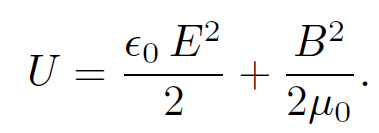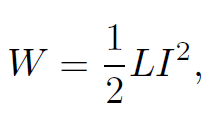


 الفيزياء الكلاسيكية
الفيزياء الكلاسيكية
 الكهربائية والمغناطيسية
الكهربائية والمغناطيسية
 علم البصريات
علم البصريات
 الفيزياء الحديثة
الفيزياء الحديثة
 النظرية النسبية
النظرية النسبية
 الفيزياء النووية
الفيزياء النووية
 فيزياء الحالة الصلبة
فيزياء الحالة الصلبة
 الليزر
الليزر
 علم الفلك
علم الفلك
 المجموعة الشمسية
المجموعة الشمسية
 الطاقة البديلة
الطاقة البديلة
 الفيزياء والعلوم الأخرى
الفيزياء والعلوم الأخرى
 مواضيع عامة في الفيزياء
مواضيع عامة في الفيزياء|
Read More
Date: 10-10-2020
Date: 24-12-2020
Date: 5-11-2020
|
Energy conservation in electromagnetism
We have seen that the energy density of an electric field is given by
 (1.1)
(1.1)
whereas the energy density of a magnetic field satisfies
 (1.2)
(1.2)
This suggests that the energy density of a general electromagnetic field is
 (1.3)
(1.3)
We are now in a position to demonstrate that the classical theory of electromagnetism conserves energy. We have already come across one conservation law in electromagnetism:
 (1.4)
(1.4)
This is the equation of charge conservation. Integrating over some volume V bounded by a surface S, we obtain
 (1.5)
(1.5)
In other words, the rate of decrease of the charge contained in volume V equals the net flux of charge across surface S. This suggests that an energy conservation law for electromagnetism should have the form
 (1.6)
(1.6)
Here, U is the energy density of the electromagnetic field and u is the flux of electromagnetic energy (i.e., energy |u| per unit time, per unit cross-sectional area, passes a given point in the direction of u). According to the above equation, the rate of decrease of the electromagnetic energy in volume V equals the net flux of electromagnetic energy across surface S. Equation (1.6) is incomplete because electromagnetic fields can lose or gain energy by interacting with matter. We need to factor this into our analysis. We saw earlier that the rate of heat dissipation per unit volume in a conductor (the so-called ohmic heating rate) is E . j. This energy is extracted from electromagnetic fields, so the rate of energy loss of the fields in volume V due to interaction with matter is ∫V E . j dV . Thus, Eq. (1.6) generalizes to
 (1.7)
(1.7)
The above equation is equivalent to
 (1.8)
(1.8)
Let us now see if we can derive an expression of this form from Maxwell's equations. We start from Ampere's law (including the displacement current):
 (1.9)
(1.9)
Dotting this equation with the electric field yields
 (1.10)
(1.10)
This can be rewritten
 (1.11)
(1.11)
Now, from vector field theory
 (1.12)
(1.12)
so
 (1.13)
(1.13)
Faraday's law yields
 (1.14)
(1.14)
so
 (1.15)
(1.15)
This can be rewritten
 (1.16)
(1.16)
Thus, we obtain the desired conservation law,
 (1.17)
(1.17)
where
 (1.18)
(1.18)
is the electromagnetic energy density, and
 (1.19)
(1.19)
is the electromagnetic energy flux. The latter quantity is usually called the ''Poynting flux" after its discoverer. Let us see whether our expression for the electromagnetic energy flux makes sense. We all know that if we stand in the sun we get hot (especially in Texas!). This occurs because we absorb electromagnetic radiation emitted by the Sun. So, radiation must transport energy. The electric and magnetic fields in electromagnetic radiation are mutually perpendicular, and are also perpendicular to the direction of propagation  (this is a unit vector). Furthermore, B = E/c.
(this is a unit vector). Furthermore, B = E/c.

can easily be transformed into the following relation between the electric and magnetic fields of an electromagnetic wave:
 (1.20)
(1.20)
Thus, the Poynting flux for electromagnetic radiation is
 (1.21)
(1.21)
This expression tells us that electromagnetic waves transport energy along their direction of propagation, which seems to make sense. The energy density of electromagnetic radiation is
 (1.22)
(1.22)
using B = E/c. Note that the electric and magnetic fields have equal energy densities. Since electromagnetic waves travel at the speed of light, we would expect the energy flux through one square meter in one second to equal the energy contained in a volume of length c and unit cross-sectional area; i.e., c times the energy density. Thus,
 (1.23)
(1.23)
which is in accordance with Eq. (1.21).



|
|
|
|
كيف تعزز نمو الشعر الصحي؟
|
|
|
|
|
|
|
10 فحوصات مهمة يجب القيام بها لسيارتك قبل الصيف
|
|
|
|
|
|
العتبة العباسية: الستر والعفاف بالحجاب هو الفطرة الحقة التي جبل عليها الإنسان
|
|
|
|
عشرات الطالبات يصلن إلى مكان إقامة حفل التكليف الشرعي المركزي في عين التمر
|
|
|
|
قسم الشؤون الفكرية ينظّم برنامجًا لإعداد المحاضرين وصنّاع المحتوى لوفد من البصرة
|
|
|
|
أكثر من 300 طالبة من طالبات معهد القرآن النسوي يحصلن على الإعفاء العام في مختلف المراحل الدراسيّة
|